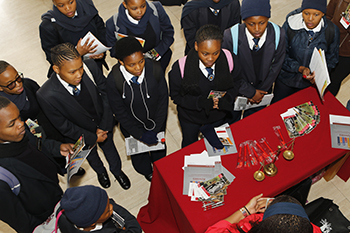
Prospective students of 2017 were treated to an Open Day filled with various activities on the Bloemfontein Campus of the University of the Free State.
Photo: Johan Roux |
"There is a great deal of political and financial pressure on universities in South Africa, and that is exactly why the country’s future leaders need to be trained at the top universities."
With these words, Prof Jonathan Jansen, Vice-Chancellor and Rector of the University of the Free State (UFS), welcomed prospective students in the Callie Human Centre on the Bloemfontein Campus as part of the Open Day held on 14 May 2016. The UFS is a place where students can fulfil their dreams.
Learners were welcomed warmly on a cold day filled with various activities, and invited to become part of the Kovsie family. Prospective students were treated to many surprises, like a laser show and a performance by South African Music Award-nominated artist, Kyle Deutsch, who performed his popular crowd hit, ‘Back to the beach’, at the informal welcoming ceremony.
Examples of true Kovsies
Prof Jansen said at the official welcoming that graduating from the UFS does two things: It gives a student a Kovsie degree, and it helps to make them decent human beings in a divided country. He encouraged the learners to be as humble as the World 400m champion, Wayde van Niekerk, and to love without borders like Tanya Calitz, the Kovsie Dux of 2015. They are examples of what it means being a true Kovsie.
An information centre – which included on-site applications and a stall with KovsieGear merchandise – was stationed in the H van der Merwe Scholtz Hall, while residences and student associations also had stalls on campus. In the Main Building, parents were able to meet Prof Jansen.
Deans and faculties encourage
Apart from various presentations and interaction with staff, the learners were also welcomed by the deans of their faculties. Prof Danie Vermeulen, Dean of the Faculty of Natural and Agricultural Sciences, said they must study what they love. “Live your own dream. That is why you come to university.”
“The UFS Faculty of Education is a training centre for leaders. We develop leaders with a commitment to serving the community,” said Prof Sechaba Mahlomaholo, Dean of the Faculty of Education.
Click here to see a highlights video of the Bloemfontein Campus Open Day, or here for a video of the Qwaqwa Campus Open Day.